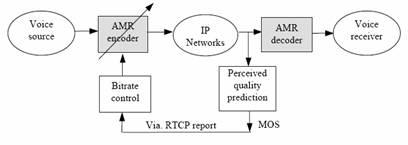Developing an improved quality of service control technique for voip
Abstract
In this paper, the application of perceived voice quality prediction in Quality of Service (QoS) control techniques for Voice over IP (VoIP) is investigated and an improved quality of service control technique has been proposed. Here, the perceived speech quality is used as a control metric to control the send behavior (i.e. the sender bit rate of codecs) instead of using traditional individual network parameters (e.g. packet loss, jitter or delay) for QoS control. Finally, a combined control scheme which combines the strength of adaptive bit rate control and priority marking control is investigated.
Introduction
Packet voice technology uses the existing data networks for offering voice. Since packet networks offer the capability for multiplexing, voice packets travel over the Internet just as data packets do. But in the case of packet switched networks, delay becomes an important issue. The perceived quality of a voice call is delay sensitive. The time sensitive voice packets and the regular data packets share the same single network, so guaranteeing the QoS of internet applications from end-to-end is difficult. The QoS level of VoIP systems depends on many parameters including the end-to-end delay, jitter, packet loss in the network, type of codec used, length of voice data, and the size of the jitter-absorbing buffer etc. QoS control mechanisms for VoIP should aim to make optimum use of available network/terminal resources and to minimize the effects of network impairments on voice quality. So, further investigations are needed to clarify the factors affecting QoS.
An important class of QoS control technique involves rate control (i.e. QoS control is achieved by automatically adjusting the send bit rate depending on network congestion conditions). However, current rate control mechanisms are based largely only on network impairments such as packet loss rate or delay during congestion. The strategy is to control the sender behavior, using the network impairments, from the receiver or the network node but this may not be sufficient to provide optimum QoS, in terms of the voice quality delivered, because the control information is directly linked to user perceived quality.
A second important class of QoS control techniques exploits knowledge of the fact that different parts of speech have different perceptual importance and so do not contribute equally to the overall voice quality. In this approach, voice packets that are perceptually more important are marked, i.e. given priority, and so are less likely to be dropped than packets that are of less perceptual importance, if there is congestion. The priority marking based QoS schemes are open loop and do not make use of changes in the network impairments.
QoS control schemes
1. Rate-adaptive QoS control scheme
The adaptive rate QoS control scheme based on AMR (Adaptive Multi-Rate) codec is shown in Fig.1. In the scheme, the send rate of the AMR codec is adjusted in accordance with the network conditions to achieve the best possible QoS. The bit rate control mechanism is based on individual network parameters (e.g. packet loss rate and delay) or on the predicted, perceived speech quality (e.g. MOS (Mean Opinion Score) score) [1]). In VoIP applications, the feedback information can be sent via RTCP (Real-time Transport Control Protocol) reports [2]. The specification of RTP (Real-time Transport Protocol) stipulates that the RTCP traffic does not exceed 5% of the whole traffic and that the time between the reports is at least 5sec [2].

Fig.1: Rate-adaptive QoS control scheme